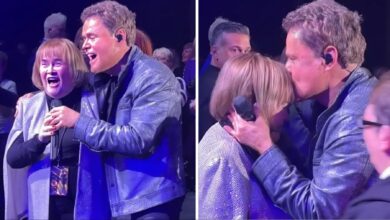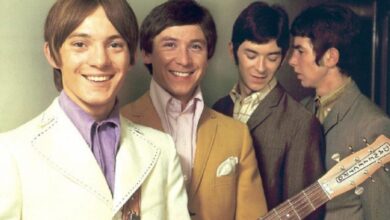Jason Donovan’s “Sealed With a Kiss” Tops the Charts in 1989 but Fades From Memory
In the summer of 1989, Jason Donovan’s rendition of “Sealed With a Kiss” soared to number one on the UK Singles Chart, capturing the hearts of listeners with its emotional sincerity. A reimagining of Brian Hyland’s 1962 classic, Donovan’s version brought a nostalgic charm to a new generation. Released during a peak in his career, the cover capitalized on his popularity as both a pop star and a television icon. However, despite its initial success, “Sealed With a Kiss” struggled to maintain a lasting legacy, becoming a fleeting memory in the collective consciousness of pop music.
Jason Donovan’s rise to fame was meteoric. Born in Melbourne, Australia, in 1968, he found stardom as Scott Robinson on the popular soap opera Neighbours, starring alongside Kylie Minogue. The on-screen romance between Donovan and Minogue captured global attention, propelling both actors into pop careers. Under the guidance of the prolific production trio Stock Aitken Waterman, Donovan transitioned from television star to chart-topping singer. Known for their signature polished sound, the production team helped mold Donovan into one of the late ’80s’ most recognizable pop figures.
The decision to cover “Sealed With a Kiss” was a strategic one. Written by Gary Geld and Peter Udell, the song had already enjoyed enduring popularity, particularly through Brian Hyland’s hit version. The melancholic ballad, with its themes of summer romance and impending separation, resonated across generations. By selecting a familiar classic, Donovan and his producers ensured the song would evoke nostalgia while appealing to younger audiences unfamiliar with the original.
Recorded under the direction of Stock Aitken Waterman, Donovan’s version retained the emotional core of the original but with a contemporary twist. The producers employed their characteristic clean, radio-friendly production style, incorporating soft strings and understated percussion. Unlike their typical upbeat tracks, “Sealed With a Kiss” showcased Donovan’s vocal sensitivity. His heartfelt delivery and earnest tone gave the song an intimate quality, although some critics noted that it lacked the raw vulnerability that made Hyland’s version so iconic.
Upon its release, “Sealed With a Kiss” was met with immediate commercial success. It topped the UK charts and enjoyed strong airplay across Europe and Australia. For Donovan, the single marked his third UK number-one hit, reinforcing his dominance on the pop scene. Yet, while it performed well in the short term, it failed to generate the kind of lasting cultural resonance that often defines classic songs.
The track’s impact on the industry was similarly muted. Unlike other major covers that sparked conversations or revitalized genres, Donovan’s “Sealed With a Kiss” was viewed primarily as a commercially driven choice. While it demonstrated his versatility and ability to connect with ballads, it did little to push the artistic boundaries of pop music. The song’s polished production also contributed to its ephemeral nature, blending into the landscape of formulaic pop hits that characterized the late ’80s.
For Donovan, the song was both a triumph and a turning point. While it extended his chart success, it also underscored the limitations of his manufactured pop persona. As the early ’90s arrived and musical tastes shifted, Donovan’s career faced challenges. Attempts to reinvent himself and shed his teen idol image proved difficult, and the overwhelming association with tracks like “Sealed With a Kiss” made it harder to gain credibility as a mature artist.
Despite its limited influence on the music landscape, “Sealed With a Kiss” remained a memorable chapter in Donovan’s career. It reflected the era’s reliance on nostalgia and the commercial appeal of familiar melodies. For fans, it was a sentimental reminder of Donovan’s peak years and the height of the Stock Aitken Waterman era. However, as time passed, the song gradually faded from public memory, lacking the cultural staying power of its predecessors.
Cover versions typically breathe new life into classics, often reshaping their meaning or introducing them to new audiences. Yet Donovan’s take on “Sealed With a Kiss” remained firmly tethered to its original interpretation. While it garnered momentary acclaim, it did little to reinterpret or modernize the track. This faithful replication, while respectful, ultimately contributed to its transient impact.
Even with its decline in prominence, the song remains a curious footnote in the annals of pop music. Unlike other covers that revitalized their source material, Donovan’s version is rarely cited in discussions about influential remakes. Its presence on oldies playlists and nostalgic compilation albums serves as a reminder of its fleeting dominance, but it no longer commands the widespread recognition of its chart-topping days.
For Brian Hyland, whose original version retains its place in the pantheon of early ’60s ballads, Donovan’s cover did little to overshadow his legacy. In fact, it may have introduced younger listeners to Hyland’s emotive performance, serving as an entry point into the golden age of pop. Yet, the cover remains more closely tied to Donovan’s image than to the broader cultural narrative of the song itself.
Ultimately, Jason Donovan’s “Sealed With a Kiss” exemplifies the unpredictable nature of pop stardom. A number-one hit one day and a forgotten melody the next, it reflects the fleeting trends of the music industry. While it may not have secured a permanent place in the cultural memory, it stands as a testament to Donovan’s ability to capture the emotional spirit of a timeless love song — even if only for a moment.



